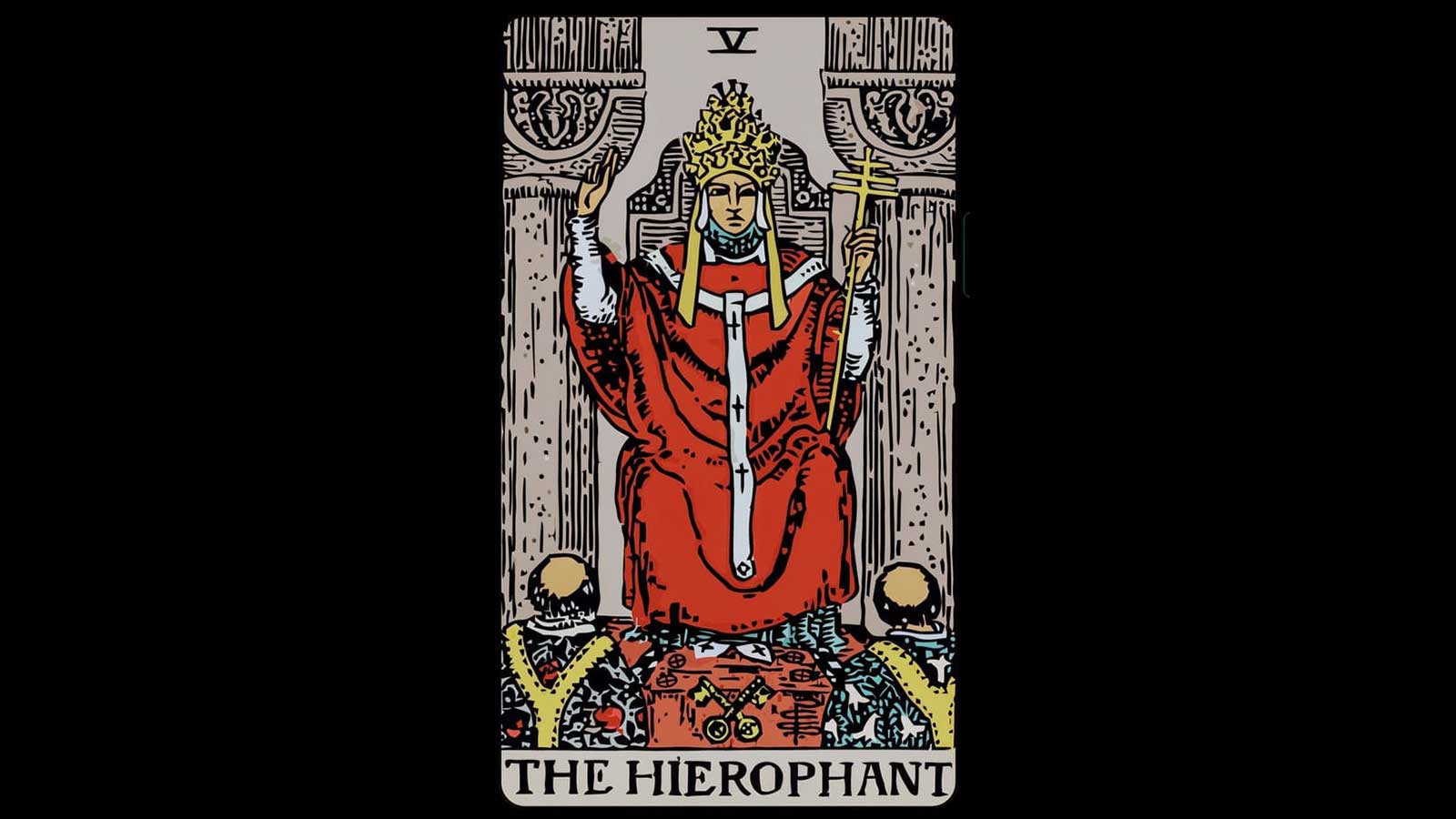So, you’re at a crossroads, and the Hierophant appears in your tarot spread. What message does this figure of tradition and established wisdom hold for you? This guide deciphers the Hierophant’s meaning in a yes/no reading, exploring its nuances and offering practical insights for love, career, and beyond.
Decoding the Hierophant’s Yes or No
The Hierophant, steeped in tradition and wisdom, isn’t a simple on/off switch. Think of it as a wise mentor offering guidance rather than a direct answer. Its presence suggests a need to consider established structures and conventional wisdom.
The Upright Hierophant: A Qualified “Yes”
When upright, the Hierophant leans towards “yes,” but it’s rarely unconditional. It’s more of a “yes, if…” or “yes, but…” – a qualified affirmation. Imagine seeking permission from a respected elder. They’re likely to grant it, but probably with certain conditions or expectations. This aligns with the Hierophant’s energy, suggesting a positive outcome if you’re willing to play by the rules. Success is probable if you adhere to convention, respect tradition, and seek guidance from established authorities. Think working within the system, like getting married in a traditional ceremony or applying for a loan through official channels. Are you feeling overburdened and exhausted? Perhaps the answer lies within the insightful interpretation of the ten of wands reversed.
The Reversed Hierophant: Challenging Convention
A reversed Hierophant isn’t necessarily a “no,” but rather a rebellious “yes,” or perhaps a “yes, but I’ll do it my way.” It signifies a departure from tradition, a challenge to established norms, and a desire to forge your own path. This doesn’t automatically mean a negative result; it suggests the path to “yes” lies outside conventional methods. Consider scenarios like launching your own business instead of climbing the corporate ladder or choosing a spiritual path outside organized religion. Perhaps a lack of collaboration and recognition is holding you back? Delve into the possible meanings behind the three of pentacles reversed and unlock a path towards collaborative success. This might entail some conflict or resistance, but the reversed Hierophant suggests that true success may lie in finding your way, even if it means breaking the mold.
The Hierophant in Love: Tradition and Transformation
Decoding the Hierophant in Love: Tradition, Commitment, and Your Relationship’s Future
Pulling the Hierophant in a love reading signifies a connection grounded in traditional values – commitment, long-term partnerships, and potentially marriage. It suggests a relationship built on shared beliefs, mutual respect, and a desire for stability, valuing family and seeking guidance from wiser figures. The Hierophant in love readings signifies a “conditional yes,” pointing towards traditional commitments and the influence of societal norms. This card urges introspection: Are your choices in love truly your own, or are they shaped by external pressures? Beyond a simple yes/no, the Hierophant explores the depth and maturity of feelings, indicating potential for lasting unions or a deepening of existing bonds. A reversed Hierophant in a love reading suggests a cautious yes, highlighting the need for careful consideration and open communication.
An upright Hierophant often points towards seeking advice and mentorship, leaning on the wisdom of those who have walked the path before you. It might also indicate a connection deeply rooted in spiritual or religious values. This emphasis on tradition doesn’t necessarily mean a rigid relationship; it can symbolize a deep, enduring bond.
A reversed Hierophant, however, often signals a rebellion against tradition, perhaps a non-traditional partnership or a desire to break free from societal expectations. It could represent a relationship that challenges the status quo, like a same-sex partnership or a polyamorous relationship. It also might represent a need to question established norms and create your own path. In a reversed position, the Hierophant encourages open communication and careful consideration, reminding us that sometimes, breaking the mold is necessary for true happiness.
In yes/no love readings, the Hierophant’s “yes” is conditional. Upright, it implies a “yes” if your path aligns with tradition. Reversed, it still suggests a “yes,” but with a caveat: proceed thoughtfully, challenge assumptions, and be prepared to deviate from the norm.
While the Hierophant often represents positive aspects of love like commitment and stability, it also has a shadow side. Its emphasis on tradition can sometimes lead to rigidity and an unwillingness to adapt. Blindly following convention can stifle individuality and prevent growth. Therefore, it’s important to consider the potential downsides of adhering too strictly to established norms. The Hierophant’s presence encourages you to explore deeper questions. What does spirituality mean to you and your partner? How do you navigate evolving social norms around partnerships and marriage? Remember, tarot offers insights and explores possibilities, guiding you towards a deeper understanding of your relationship dynamics and the role tradition plays in your love life.
The Hierophant in Career: Structure and Innovation
In career readings, an upright Hierophant often signifies mentorship, apprenticeships, and working within established hierarchical structures. It suggests finding success through traditional career paths and respecting authority. Conversely, a reversed Hierophant could point towards entrepreneurship, freelance work, or any career path outside the traditional 9-to-5. It suggests you may find fulfillment by creating your own structure and challenging conventional career models.
Is the Hierophant Positive or Negative? Decoding its Complex Meanings
The Hierophant isn’t simply positive or negative; it’s nuanced, like a wise owl whose hoot can be both a cheerful affirmation and a cautious warning. It signifies structured progress within established systems, positive when aligned with tradition, potentially negative when resisting it. While often associated with “yes,” it represents conformity and tradition; a positive outcome depends on embracing these, while “no” suggests a break from them. The Hierophant’s influence depends on the question’s context. For traditional matters, it leans towards “yes.” For rebellious pursuits, it might indicate challenges. Upright, it encourages seeking guidance; reversed, it calls for independent thought. Its positivity lies in discerning which path suits your situation.
Upright, it embodies tradition, order, wisdom, mentorship, spiritual guidance, conformity (within healthy boundaries), structure, and stability. It indicates that following an established path will likely lead to success, encouraging guidance from experienced mentors. Reversed, it can represent blind adherence to tradition, resistance to change, rigidity, rebellion, challenging authority, and breaking free from restrictive structures. It suggests questioning established norms and possibly forging a new path, signaling a “no” if the question involves strict adherence to tradition.
What is the Advice of the Hierophant? Unlocking its Wisdom
The Hierophant’s advice transcends a simple “yes” or “no.” It whispers of tradition, conformity, and established wisdom—a resounding “yes” for aligning with established structures, a cautious approach to breaking free. Reversed, it challenges blind faith, urging you to question tradition, a hesitant “yes” to embracing individuality. Beyond yes/no, it advises seeking mentorship and structured learning. In love, it signifies commitment, traditional values, seeking blessings—a “yes” to conventional relationships, a cautious “yes” to challenging norms.
It encourages seeking answers within established systems and learning from experienced figures. Upright, it generally indicates “yes,” especially for traditional areas like marriage, education, and religion, representing conformity, structure, guidance, spiritual education, and established wisdom. Reversed, it suggests a hesitant “yes” or “maybe,” indicating a potential departure from tradition or a need for careful consideration, potentially signaling rebellion or independent thought. In love readings, upright signifies commitment, tradition, seeking blessings, and marriage, while reversed suggests breaking free from unhealthy traditions, questioning norms, needing independence, or shedding outdated patterns.
Beyond Yes and No: The Hierophant’s Deeper Wisdom
The Hierophant’s message is rarely a binary “yes” or “no.” It encourages us to delve into the context: What traditions and structures are at play? Are you respecting or challenging them? The Hierophant isn’t about blind obedience; it’s about understanding the framework before working within or challenging it. It prompts us to ask: What are the rules, and why are they there? True wisdom comes not just from an answer but from understanding the question itself. Perhaps exploring the question will illuminate your path. The Hierophant guides us to seek deeper understanding, reminding us that true wisdom lies not just in receiving an answer, but in understanding the question itself. Perhaps, exploring the question itself will illuminate your path forward.
- Discover Long Black Pepper: Flavor & Health Benefits - April 25, 2025
- Shocking Twists: The Grownup Review: Unreliable Narration - April 25, 2025
- A Quiet Place Book vs Movie: A Deep Dive - April 25, 2025
















